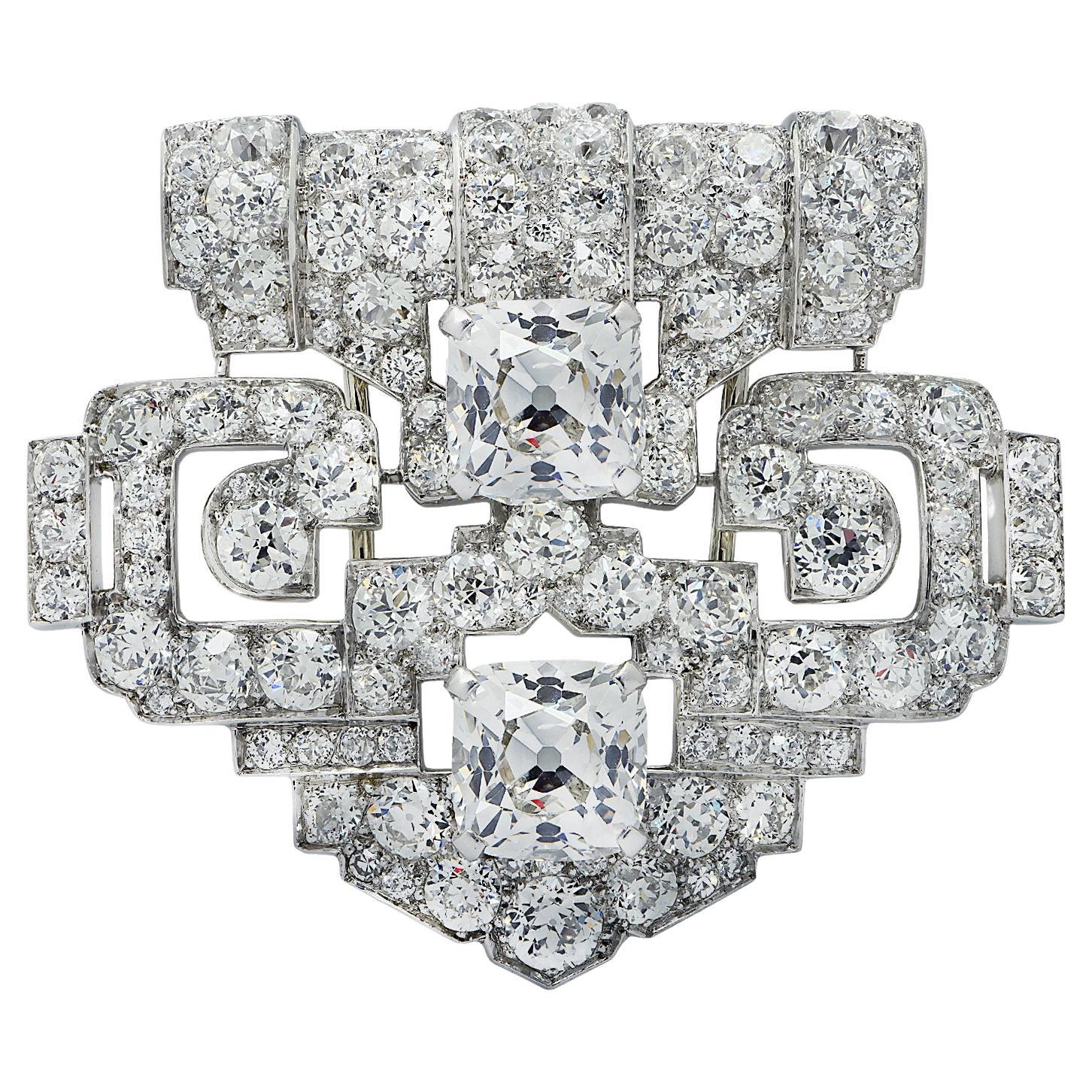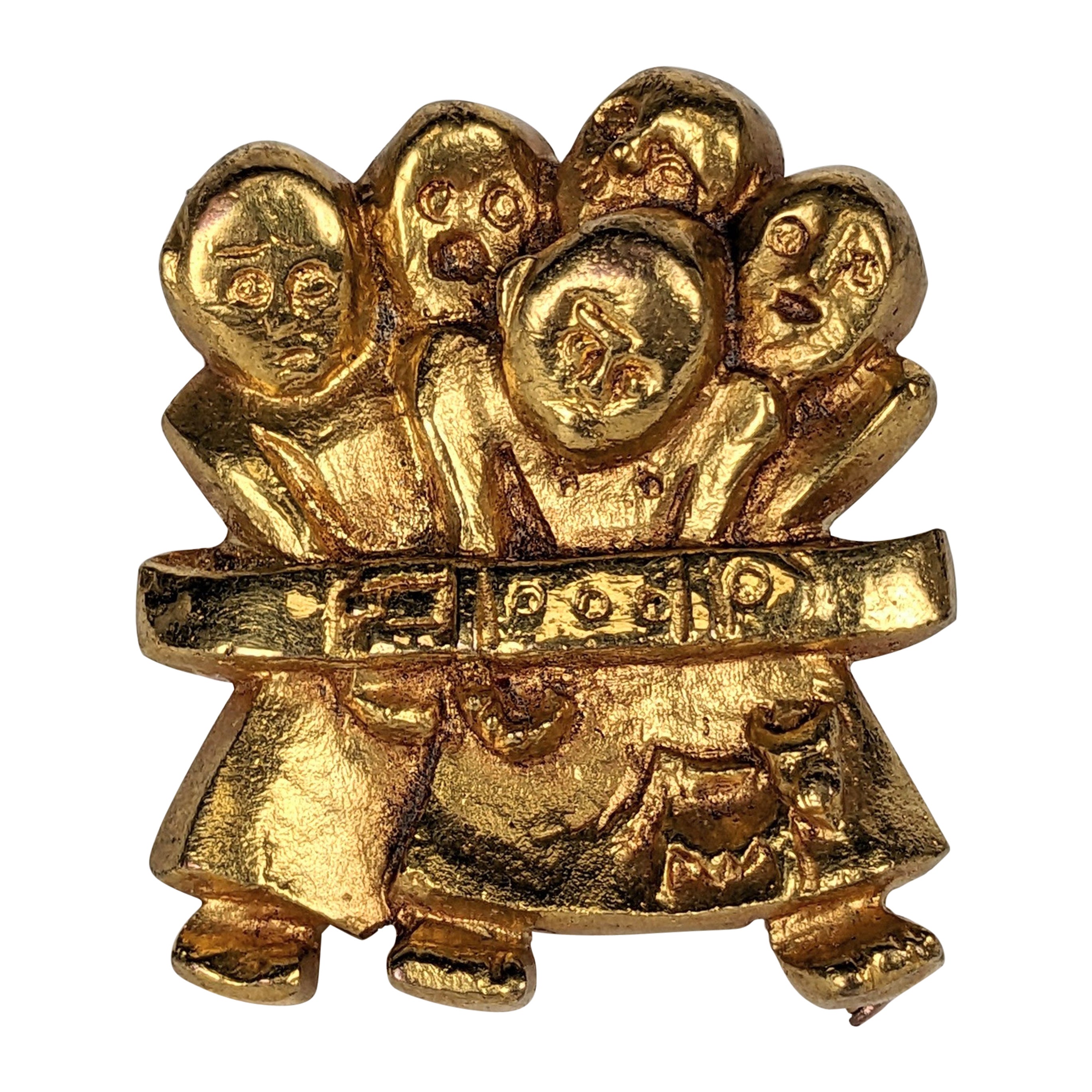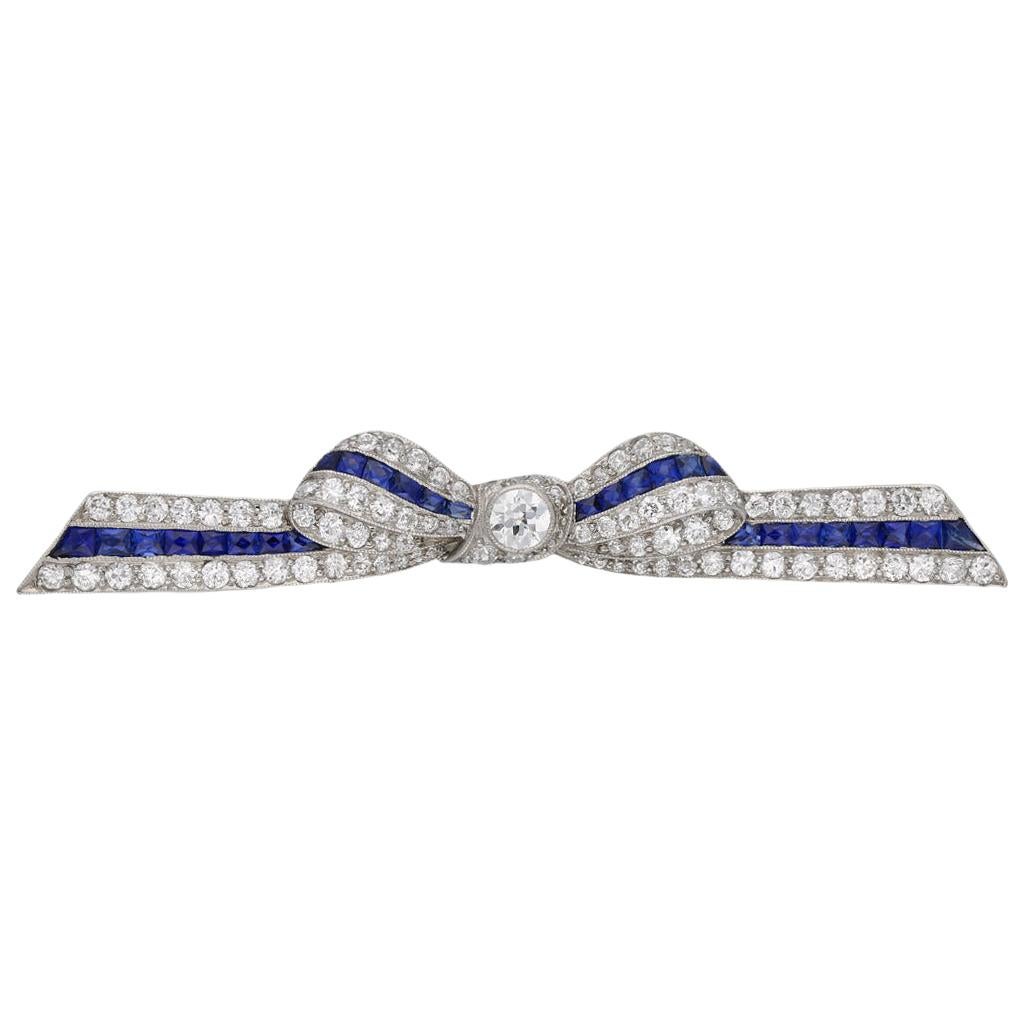Items Similar to A very rare ornate 'quiver' brooch, Christian Dior by Mitchel Maer, early 1950s
Want more images or videos?
Request additional images or videos from the seller
1 of 12
A very rare ornate 'quiver' brooch, Christian Dior by Mitchel Maer, early 1950s
About the Item
A very rare and important jewel by Christian Dior from the early 1950s, Most unusual and striking , typically French and full of reference to past times, this brooch was made by Mitchel Maer and is of the highest quality, as expected from both Dior and the Mitchel Maer studio. Easy and eye catching to wear - or simply to admire - this would be a wonderful addition to any established or new collection of 20th century costume jewellery.
American Mitchel Maer settled in England, where he started his own jewellery manufacturing business in the early 1950s. It was of the highest quality and finest craftsmanship.
It was because of these characteristics that, during a short period (1954 to 1956), the company was commissioned to create jewellery for Christian Dior, producing some of the most stunningly beautiful jewellery ever made.
Most of the designs were produced in Paris and then sent to Mitchel Maer, for refining, Mitchel Maer producing some of the designs himself.
A wide variety of subjects were used, the imagery mainly referring back to the 18th century in France, as seen in Dior’s clothes of this time, echoing a time of high femininity and escape from the strictures and rationing of the Second World War.
Flowers, (some ‘en tremblant’ which was a highly successful line), birds, imagery from French history such as dolphins, swans (Dior’s favourite bird), and ‘hippocamps’ (flying horses with fish’s tails), as well as some heraldic images, were amongst the rich world created with the jewellery.
Sadly it was only a very short but highly intense and productive collaboration between the two, with Christian Dior’s untimely and sudden death in 1957, and Mitchel Maer encountering financial difficulties.
- Creator:
- Metal:Gilt Metal
- Weight:28 g
- Dimensions:Height: 3.3 in (83.82 mm)Width: 1.25 in (31.75 mm)Depth: 0.3 in (7.62 mm)Length: 3.3 in (83.82 mm)
- Style:Baroque
- Place of Origin:United Kingdom
- Period:1950-1959
- Date of Manufacture:c1952
- Condition:Wear consistent with age and use.
- Seller Location:Greyabbey, GB
- Reference Number:
About the Seller
5.0
Vetted Seller
These experienced sellers undergo a comprehensive evaluation by our team of in-house experts.
Established in 1988
1stDibs seller since 2015
249 sales on 1stDibs
Typical response time: 6 hours
- ShippingRetrieving quote...Ships From: Greyabbey, United Kingdom
- Return PolicyA return for this item may be initiated within 7 days of delivery.
More From This SellerView All
- A Black Galalith, silver and clear paste clip, Mecan, France, 1930sLocated in Greyabbey, County DownA very stylish and rare jewel, high Art Deco in style and manufacture. This is a clip fitting, bold and strong, that would clip onto a clutch bag, a lapel, or on the edging of a low ...Category
Vintage 1930s French Art Deco Brooches
MaterialsSilver
- Art Deco style paste and enamel brooch, Ciner, USA, 1990sBy CinerLocated in Greyabbey, County DownA large and dynamic brooch in high Art Deco style from Ciner, New York. Although made from base metal, enamel and paste, it echoes the wonderful designs of Cartier and Van Cleet and ...Category
1990s American Art Deco Brooches
MaterialsBase Metal
- An iconic gilt metal 'Sun face' brooch, Yves Saint Laurent, France, 1980sBy Maison Goossens for Yves Saint LaurentLocated in Greyabbey, County DownAn iconic brooch from Yves Saint Laurent in the 1980s, a familiar and popular design justifiably so. Hand carved then cast in gilded metal by Maison Goossens for YSL...Category
Vintage 1980s French Brooches
MaterialsGilt Metal
- A beautiful gilt and clear paste 'grasshopper' brooch, Nettie Rosenstein, 1960s.By Nettie RosensteinLocated in Greyabbey, County DownAn exquisitely modelled three dimensional brooch in the form of a grasshopper, from mid century American fashion designer , Nettie Rosenstein. Of outstanding quality, this brooch dep...Category
Vintage 1960s American Brooches
MaterialsGilt Metal
- Deep ruby paste 'cruxiform' brooch and earrings, Warner, USA, 1950sBy WarnerLocated in Greyabbey, County DownA glorious deep ruby red gives this eye catching brooch and earrings its charm and allure. Set in black lacquered metal with teardop and round pastes, in a very three dimensional design, this is a very wearable set, either together or individually. Only the brooch is signed. Founded by Joseph Warner...Category
Vintage 1950s American Clip-on Earrings
MaterialsBase Metal
- Gilt metal, fuschia and amethyst paste brooch/earrings, Christian Dior, c. 1954By Mitchel Maer for Christian DiorLocated in Greyabbey, County DownAn unusual brooch and earrings from Christian Dior by Mitchel Maer, made of articulated twisted gilt rings of various sizes, highlighted with amethyst, light amethyst and fuschia pas...Category
Vintage 1950s British Brooches
MaterialsGilt Metal
You May Also Like
- Cartier New York GIA Certified 11.24 Carat Old Mine Cushion Diamond BroochBy CartierLocated in Miami, FLMagnificent Cartier Art Deco Platinum and Diamond Brooch featuring a matching pair of important Old Mine Cut Diamonds weighing 5.60 carats and 5.64 carats. Both accompanied by a GIA report stating that they are H color VS1 and H color VS2 clarity. This brooch comes with an Expertise letter from IAJA (international Antique Jewelers...Category
Vintage 1930s American Art Deco Brooches
MaterialsDiamond, Platinum
- Carved Coral Buddha Pendant in 18k Gold Set with Diamonds, Emeralds and RubiesLocated in Honolulu, HIMAGNIFICENT large vintage Buddha pendant brooch in 18K yellow gold. This gorgeous pendant features a stunning Buddha carved in natural coral set...Category
Late 20th Century Unknown Pendant Necklaces
MaterialsCoral, Diamond, Emerald, Ruby, 18k Gold
- Line Vautrin "La Manif" Gilt Bronze BroochBy Line VautrinLocated in New York, NYGilt brooch by Line Vautrin (1913-1997), circa 1945-46. The design is known as ...Category
Vintage 1950s French Artisan Brooches
MaterialsBronze, Gilt Metal, Gold Plate, Brass
- Vintage Ruby Onyx and Diamond Classic Car BroochLocated in London, GBHere we have a superb vintage brooch. The piece has been crafted from 18ct yellow gold into the shape of a classic car from the 1930s. Automobiles of the 1930s exhibited many notable...Category
Vintage 1930s Brooches
MaterialsDiamond, Onyx, Ruby, Gold, Yellow Gold, Enamel
- Marcus & Co. Sapphire and Diamond Bow Brooch, American, circa 1935Located in London, GBSapphire and diamond bow brooch by Marcus & Co, American, circa 1935. A yellow gold and platinum bow form brooch set with one central row of twenty eig...Category
Vintage 1930s American Art Deco Brooches
MaterialsDiamond, Sapphire, Platinum
- John Brogden Shell Cameo Brooch and Earrings, English, circa 1870By John BrogdenLocated in London, GBAntique shell cameo brooch and earrings by John Brogden, English, circa 1870. A yellow gold suite of jewellery, the brooch composed of a horizontally situated oval Bull’s Mouth shell cameo of the Greek goddess Selene riding a serpentine dragon in a rubover collet setting, encircled by a conforming frame of gold beading and twisted gold wire punctuated with four gold palmette form plaques engraved and decorated with dark blue enamel and placed at the cardinal points, the reverse mounted with a hinged pin and scroll clasp, the earrings each composed of a vertical oval Bull’s Mouth shell cameo engraved with a bust length portrait of Selene with crescent-set headdress, encircled by a conforming frame matching that of the brooch with the addition of a pendant decoration composed of a horizontal bar of gold beading and twisted gold wires suspending gold link chains graduated from centre and ending in conical gold elements, the reverses mounted with French wire fittings, all in a fitted red leather case, the interior marked ‘FIRST CLASS PARIS MEDAL/ 1855.1867.1851/ PARIS FIRST CLASS & LONDON PRIZE MEDALS/ JOHN BROGDON/ Goldsmith/ MANUFACTORY/ 16, Henrietta St. Covent Garden/ London’. The cameo—defined as a gem, usually either a mineral or a shell, upon which a design has been carved in relief—is believed to have originated in Hellenistic Greece, during the third century BC. These miniature sculptures, at that time confined to the medium of hardstone, are thought to have been made with the primary purpose of personal adornment. The same practice of mounting cameos in jewellery was then continued by the Ancient Romans, and they are known to have been worn by many a Roman emperor. After the fall of Rome the fashion for cameos went into a decline, until it was again revived during the Renaissance period, brought about by a keen interest in the ancient world. At this time both antique and contemporary cameos were mounted in jewellery, as well as collected as objet d’art. The art of cameo cutting was revived in Italy, where it would remain a centre for the coming centuries. Again there was a lull in interest in carved gemstones, until the Neoclassical revival of the eighteenth century, largely stimulated by the discoveries of the ancient Roman cities of Pompeii and Herculaneum. As with the Renaissance, antique specimens were generally prized over modern cameos, and the worldliest men in Europe held them among their collections of art and antiques. That said, carving centres in Rome and Torre del Greco (near Naples) in Italy were established in response to the demand of the Grand Tourists, who travelled to Italy and Greece to become educated in the wonders of the ancient world. It was at this time that shell cameos, mostly made in Torre del Greco due to its proximity to the sea, became more popular, owing to the relative ease in carving shell over hardstone. In addition to Rome, hardstone cameos also became a specialty of Idar Oberstein, Germany, which had a long history with both the gem mining and cutting trade. In a shift away from the collector’s cases of the previous century, the nineteenth century saw a strengthening in the fashion for wearable cameos. After the Empress Josephine donned a cameo-set suite of jewellery at the coronation of Napoleon in 1804, cameo jewellery became all the rage. Napoleon played a further hand in promoting the art by establishing a gemstone carving school in Paris, inspired by his appreciation for the arts of the ancient world. By the mid-nineteenth century shell cameos, in part due to their lightness compared with hardstone cameos, were the height of fashion. Large shell cameos as well as hardstone cameos were set into contemporary mounts, often as suites of jewellery. Some of the best cameos of the nineteenth century—carved by a select group of recognized carvers—were set into revivalist mounts, corresponding to the subject matter. In Victorian England cameo jewellery was particularly prized, due in part to the fact that the Queen owned and wore a number of cameo jewels. One example which can often be seen in official portraits is the Badge of the Order of Victoria and Albert, carved by Tommaso Saulini of Rome, who also produced cameos for the maker of the present suite, John Brogden. To meet demand some carvers set themselves up in London, including William Schmidt, a German carver from Idar Oberstein, who produced cameos for top London jewellers, including Brogden, Carlo Giuliano and Child & Child. In fact, Schmidt purports to have been the first to carve cameos out of opal, which Brogden reportedly displayed in the Paris Exhibition of 1878. An extant example, now in the collection of the British Museum, was set by the Giuliano firm. Regarding subject matter, cameos throughout time have been largely figural, from bust length profile portraits to scenes with multiple full-length figures, and sometimes animals. Ancient Greek and Roman cameos often depicted mythological scenes as well as contemporary figures. During the Renaissance, mythological scenes were popular, often taken directly from ancient sculpture, as well as portraits of notable contemporary figures. During the eighteenth and nineteenth centuries, due to the revivalist styles, both Renaissance and Classical subjects were copied and set into matching (and sometimes unmatching) revivalist mounts. From the Renaissance through the Victorian era, being able to recognize the source of the carving in a cameo was a mark of erudition, revealing in the wearer knowledge of Classical art. As mentioned, the present cameo parure...Category
Antique 1870s English Victorian Brooches
MaterialsYellow Gold
Recently Viewed
View AllMore Ways To Browse
Very Vintage Jewellery
Very Vintage Jewelry
Commissioned Jewelry
20th Century Costume Jewelry
Dior Jewel
Dior Jewelly
Costume Jewelry Used
Rare Vintage Costume Jewelry
Vintage Rare Jewelry 1950s
Vintage Clothes Collection
Christian Dior 1950
Dior Fish
1950s Christian Dior
Christian Dior 1959
18th Century French Jewelry
Clothes Line Vintage
Christian Dior Clothes
Fish Jewels





